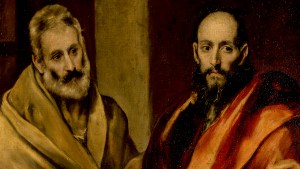The day after the Church celebrated Sts. Peter and Paul’s feast day, these two important saints came to life under the portico of St. Peter’s Basilica in a new, comical – but also profound – theatrical production, titled “Peter and Paul in Rome.”
Organized by the Vatican and the Diocese of Rome, in collaboration with the Roman municipality and the Italian Ministry for Culture, on occasion of the feast day, this theatrical exhibition presented the saints as two “brothers” who meet in Rome and discuss their lives, the Gospel, and the state of the Church.
According to tradition, Sts. Peter and Paul did meet a couple of times in their lives, such as in Jerusalem and Antioch. Then both died in Rome between the years 64 and 67.
The work was written by Italian actor, Michele Ginestra, who also played St. Peter, while St. Paul was played by Augusto Fornari; both were directed by Roberto Marafante.
Real people with real lives
In an interview with Aleteia, Franciscan Father Agnello Stoia, parish priest of St. Peter’s Basilica, spoke about how seeing these two important saints through this play allows us to draw closer to them and see their humanity.

What does this play want to tell us about the life of Sts. Peter and St. Paul?
Father Agnello: The Church has the tradition of St. Peter, who lived in Rome for many years, and the tradition of St. Paul who, as we know from the Acts of the Apostles, spent a short time in Rome – more or less two years with a restricted freedom of movement. In this play we have Peter and Paul meeting on the streets of Rome between the house of Pudente [an ancient Roman senator who is said to have hosted Peter in his home, editor’s note] and the house of Aquila and Priscilla [an ancient Roman couple close to Paul, editor’s note] … so among the first Christian communities of the time.
This play shows a meeting between two brothers. It’s nice because they remember so many things. Paul is not an eyewitness of Jesus like Peter, so it’s also an opportunity to share some memories. They also clarified some points where the two had parted a little bit badly.
We always picture them together. They had seen each other in Jerusalem and a couple of other times but it’s not like they stayed in touch by cell phone. When they had met in Antioch an issue had even occurred, resulting in Paul calling Peter a hypocrite.
In this play then they meet again in Rome after a long time and talk, including about their concerns for the Church. Played out on stage are the themes we find in the Gospel, the embrace between two people, their human history, and the personal issues they faced.
What message do you hope remains for those who have seen it? What can Sts. Peter and Paul teach us today?
Father Agnello: The message is especially that we must rediscover the relevance of these two figures, but also the vocation of Rome. Rome is a universal city because Peter and Paul walked its streets, evangelized this community and bore witness, to the point of spilling blood, of their love for Christ. In our midst are the memories of the places where Peter and Paul lived. So especially Romans need to reacquaint themselves with these memories in order to regain their identity. If a relative tells you about your family and shows you places, photo albums, it gives you back your identity.
This play was attempting to bring these saints a little closer to us, making them walk these streets, so we can understand them better.
Can you tell me a particularly funny anecdote or joke from the show?
Father Agnello: The funniest parts are some details of certain situations that St. Paul tells St. Peter and he replies ‘how do you know?’ and Paul says, ‘it was John.’ John was the youngest among them and he is keen to make it known that he was the beloved disciple. There are these little details that show the humanity of the apostles that come out throughout the play and can be funny. It is a show that makes you laugh and also moves you a lot … there is a lot of pathos.
How do you think theater can be an effective way to evangelize and make people aware of the history of Christianity?
Father Agnello: Theater is a very old tradition in the Church. Think of the sacred representations [for example, of the Nativity, editor’s note]; we Franciscans were doing them in front of churches as early as the 1200s. Then these enactments would end up in frescoes.
Then it continued, for example, with the Oratory of St. Philip Neri, with plays and songs. These expressions help to bring Saints much closer to us. These are things that have always been done in porticos or churchyards.






